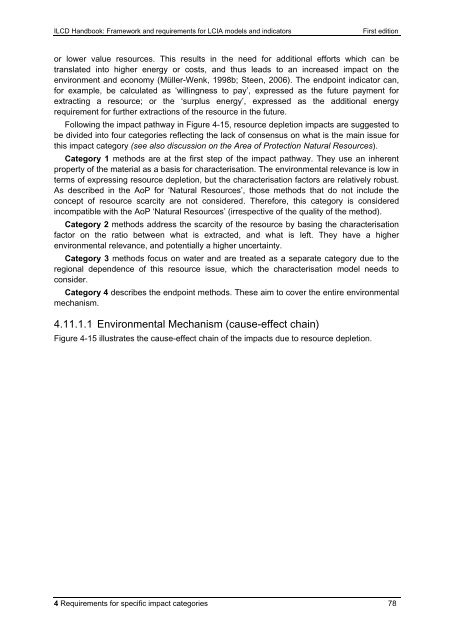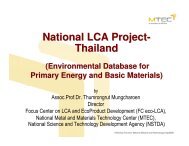ILCD Handbook: Framework and requirements for LCIA models and ...
ILCD Handbook: Framework and requirements for LCIA models and ...
ILCD Handbook: Framework and requirements for LCIA models and ...
You also want an ePaper? Increase the reach of your titles
YUMPU automatically turns print PDFs into web optimized ePapers that Google loves.
<strong>ILCD</strong> <strong>H<strong>and</strong>book</strong>: <strong>Framework</strong> <strong>and</strong> <strong>requirements</strong> <strong>for</strong> <strong>LCIA</strong> <strong>models</strong> <strong>and</strong> indicators First edition<br />
or lower value resources. This results in the need <strong>for</strong> additional ef<strong>for</strong>ts which can be<br />
translated into higher energy or costs, <strong>and</strong> thus leads to an increased impact on the<br />
environment <strong>and</strong> economy (Müller-Wenk, 1998b; Steen, 2006). The endpoint indicator can,<br />
<strong>for</strong> example, be calculated as ‗willingness to pay‘, expressed as the future payment <strong>for</strong><br />
extracting a resource; or the ‗surplus energy‘, expressed as the additional energy<br />
requirement <strong>for</strong> further extractions of the resource in the future.<br />
Following the impact pathway in Figure 4-15, resource depletion impacts are suggested to<br />
be divided into four categories reflecting the lack of consensus on what is the main issue <strong>for</strong><br />
this impact category (see also discussion on the Area of Protection Natural Resources).<br />
Category 1 methods are at the first step of the impact pathway. They use an inherent<br />
property of the material as a basis <strong>for</strong> characterisation. The environmental relevance is low in<br />
terms of expressing resource depletion, but the characterisation factors are relatively robust.<br />
As described in the AoP <strong>for</strong> ‗Natural Resources‘, those methods that do not include the<br />
concept of resource scarcity are not considered. There<strong>for</strong>e, this category is considered<br />
incompatible with the AoP ‗Natural Resources‘ (irrespective of the quality of the method).<br />
Category 2 methods address the scarcity of the resource by basing the characterisation<br />
factor on the ratio between what is extracted, <strong>and</strong> what is left. They have a higher<br />
environmental relevance, <strong>and</strong> potentially a higher uncertainty.<br />
Category 3 methods focus on water <strong>and</strong> are treated as a separate category due to the<br />
regional dependence of this resource issue, which the characterisation model needs to<br />
consider.<br />
Category 4 describes the endpoint methods. These aim to cover the entire environmental<br />
mechanism.<br />
4.11.1.1 Environmental Mechanism (cause-effect chain)<br />
Figure 4-15 illustrates the cause-effect chain of the impacts due to resource depletion.<br />
4 Requirements <strong>for</strong> specific impact categories 78



